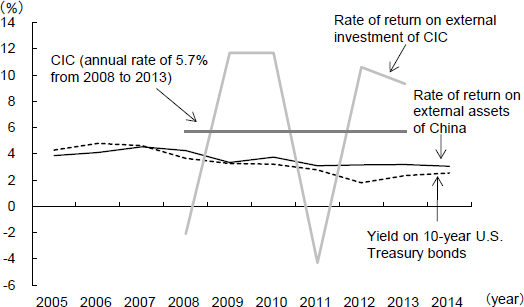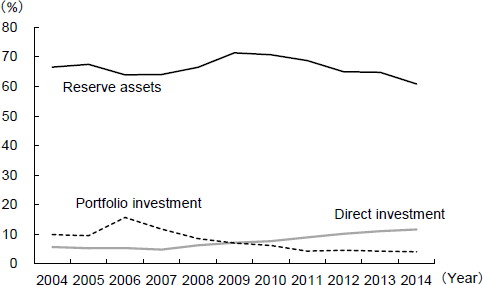China's net external assets reached $1.78 trillion at the end of 2014, making it the world's second largest net creditor nation after Japan ($3.04 trillion). Nevertheless, as the rate of return on external assets (receipts) centering on the investment of foreign exchange reserves is much lower than the rate of return on external liabilities (payments) centering on direct inward investment, the balance of investment income is still in deficit. To raise the rate of return on external assets, the Chinese government has taken such actions as (1) establishing sovereign wealth funds, (2) launching the "One Belt, One Road" (New Silk Road) vision, the Silk Road Fund, and the Asian Infrastructure Investment Bank (AIIB), and (3) encouraging outward direct investment by Chinese companies. As capital account liberalization proceeds, portfolio investment by the private sector is expected to rise significantly in the future.
Analysis based on the development stage theory of balance of payments
It is estimated that the rates of return on external assets and external liabilities in 2014 were 3.0% and 5.6%, respectively, in China, with the former well below the latter (Table 1). Reflecting this, the balance of investment income ran a deficit of $59.8 billion in 2014, despite the fact that China is a net creditor nation in the sense that its external assets exceed its external liabilities.
| Asset side | Liability side | |||
|---|---|---|---|---|
| Principal (a) ($ billions) | 6,197.4 | 4,311.2 | ||
| Investment income (b) ($ billions) | 183.1 | 242.9 | ||
| Rate of return (b/a) (%) | 3.0 | 5.6 | ||
| Note: The principal is the average of external assets (or external liabilities) at the end of 2013 and the end of 2014. Investment income is the receipt of investment income on the asset side and the payment thereof on the liability side. Source: Estimated by the author based on the "time-series data of the International Investment Position of China" and the "time-series data of the Balance of Payments of China" of the State Administration of Foreign Exchange of the People's Republic of China. | ||||
The development stage theory of balance of payments states that the balance of payments of a country can be classified into the following six patterns according to the combination of plus and minus signs in its balance of trade (goods and services), balance of investment income, and balance of current account (which combines the balance of trade and the balance of investment income): (1) a young debtor, (2) a mature debtor, (3) a debt reducer, (4) a young creditor, (5) a mature creditor, and (6) an asset liquidator. In the process of economic development, a country usually goes through these stages in order from (1) to (6) (Table 2). In terms of this theory, China is currently a debt reducer with its balance of investment income running a deficit, while its current account and balance of trade are in surplus.
| Balance of trade | Balance of current account | Balance of investment income | ||
|---|---|---|---|---|
| 1. Young debtor | - | - | - | |
| 2. Mature debtor | + | - | - | |
| 3. Debt reducer | + | + | - | |
| 4. Young creditor | + | + | + | |
| 5. Mature creditor | - | + | + | |
| 6. Asset liquidator | - | - | + | |
| Note: Balance of current account = Balance of trade + Balance of investment income Source: Prepared by the author based on Crowther, G., Balances and Imbalances of Payments, Harvard University Press, 1957. | ||||
The balance of investment income is in deficit in China despite the fact that the country's external assets are larger than its external liabilities because reserve assets (mostly foreign exchange reserves) that constitute the largest portion of its external assets (60.8% at the end of 2014) are invested mainly in U.S. Treasury bonds carrying a low rate of return, while direct inward investment with a high cost of funding accounts for a large percentage of external liabilities (57.8% at the end of 2014) (Table 3).
| China | |||
|---|---|---|---|
| Amount ($ billions) | Share (%) | ||
| Assets (a) | 6,408.7 | 100.0 | |
| Direct investment | 744.3 | 11.6 | |
| Portfolio investment | 262.5 | 4.1 | |
| Reserve assets | 3,899.3 | 60.8 | |
| Others | 1,502.6 | 23.4 | |
| Liabilities (b) | 4,632.3 | 100.0 | |
| Direct investment | 2,677.9 | 57.8 | |
| Portfolio investment | 514.3 | 11.1 | |
| Others | 1,440.2 | 31.1 | |
| Net external assets (a)-(b) | 1,776.4 | ||
| Source: Prepared by the author based on the "time-series data of the International Investment Position of China" of the State Administration of Foreign Exchange of the People's Republic of China. | |||
Efforts to increase the rate of return on investment
To increase the rate of return on external assets, China has to reduce the share represented by foreign exchange reserves and raise the share represented by other assets. To this end, the government in recent years has been taking the following steps.
First, in 2007, the government established the China Investment Corporation (CIC), a kind of a sovereign wealth fund (SWF), to promote portfolio diversification from U.S. Treasury bonds to other currencies and financial assets. According to the CIC's Annual Report 2013, the share of external assets comprised of bonds was only 17.0% at the end of 2013, other investment instruments with a higher risk accounted for a larger share, including stocks of listed companies, which accounted for 40.4%. Thanks to this strategy of portfolio diversification, the annual rate of return on external assets of the CIC was 9.3% in 2013 and 5.7% on average from 2008 to 2013, much higher than not only the yield on 10-year U.S. Treasury bonds, the benchmark, but also the rate of return on the overall external assets of China (Figure 1). However, the risk of investment has risen in proportion to the rise in the rate of return, and wide fluctuations in the rate of return are a sign of this propensity.
--Comparison with the Rate of Return on External Assets of China and the Yield on 10-year U.S. Treasury Bonds--

China is also promoting its own version of the Marshall Plan centering on the One Belt, One Road vision and financial assistance to developing countries. Specifically, China plans to invest $10 billion in the Silk Road Fund, $29.8 billion in the AIIB, and $10 billion in the New Development Bank (NDB). These developments should pave the way for further investment overseas.
In addition, the government encourages outward direct investment by Chinese companies. China has long been acquiring foreign funds and technologies through inward direct investment and achieving high growth with this as the driving force. On the other hand, for a long time, outward direct investment by Chinese companies had been small, partly because of strict capital controls. In recent years, however, it has been rising sharply, thanks to the government's support and the rising strength of Chinese companies. From the end of 2004 to the end of 2014, the stock of outward direct investment increased from $52.7 billion to $744.3 billion, and its share of external assets also rose from 5.7% to 11.6% (Figure 2). Thus, direct investment involving China is changing from the traditional one-way traffic dominated by inflow to a more balanced bidirectional flow.

In contrast to direct investments, the share of external assets represented by reserve assets has been falling from a peak of 71.4% in 2009 to 60.8% in 2014.
Although cross-border portfolio investment has been partially deregulated with the introduction of the qualified foreign institutional investor (QFII) system, the qualified domestic institutional investor (QDII) system, and the Shanghai-Hong Kong Stock Connect, the share of external assets and external liabilities accounted for by portfolio investment is still small, as the quota limits are still low. However, with these quota limits set to increase in the future as China further opens its capital account, the securities market in China will become an important investment destination for foreign investors, while investment in foreign securities by Chinese investors is also expected to increase significantly.
This changing pattern of investment will improve the rate of return on China's external assets. Given the additional factor that net external assets are likely to continue increasing, reflecting the ongoing surplus in the current account, the balance of investment income in China is expected to ultimately move into the black. In terms of the development stage theory of the balance of payments, China seems to be heading from the stage of a debt reducer to that of a young creditor, with its balance of trade, balance of current account, and balance of investment income all in surplus.


